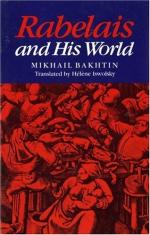
|
| Name: _________________________ | Period: ___________________ |
This test consists of 5 multiple choice questions, 5 short answer questions, and 10 short essay questions.
Multiple Choice Questions
1. What happened to Rabelais after his novel was published?
(a) He was praised for his honest portrayals of the people and given a government pension.
(b) He was attacked by the Church and the government, but he remained free and successful.
(c) He was severely censured by the Church, then imprisoned and killed.
(d) He was questioned about his loyalty to France, then drafted into the army.
2. Goethe traces the roots of Carnival to the:
(a) Greeks.
(b) Phoenicians.
(c) Mesopotamians.
(d) Romans.
3. The defense of the abbey by Friar John contains:
(a) A caricature of the Pope.
(b) A travestied allusion to Communion.
(c) A debasing description of the French people.
(d) A grotesque combination of sexual intercourse and war.
4. In Medieval satires, the dismemberment of portions of the body relates to:
(a) The separate portions of society.
(b) The human body itself.
(c) The topography of the continents.
(d) The general conception of the divine.
5. What are the languages involved in what Bakhtin terms the "triple linguistic process" of Rabelais' time?
(a) Medieval Latin, Middle French, and Middle German.
(b) Medieval Latin, Old French, and Middle French.
(c) Classic Latin, Middle French, and vernacular French.
(d) Classic Latin, Medieval Latin, and vernacular French.
Short Answer Questions
1. Bakhtin asserts that "The Play in the Bower" influenced Rabelais' work specifically in its:
2. In which element of Shakespeare's dramas does Bakhtin see the overall theme of Rabelais' carnivalesque repeated?
3. To what are "swabs" most closely related?
4. What is a Renaissance "diablerie"?
5. What word characterizes Medieval thinking, according to Bakhtin?
Short Essay Questions
1. What is the significance of Friar John's description of the monastery belfry as "fecund"?
2. What is the role of games in Rabelais' work?
3. What did the Medieval stage resemble?
4. What is significant about the language in which Rabelais writes and the sources of many of his words?
5. Discuss the significance of Gargantua's birth.
6. Describe the figure of "Gros Guillaume" and his significance to Rabelais' novel.
7. How did games and gaming change after the Renaissance?
8. Why are eating and drinking two of the most important manifestations of the grotesque body?
9. How does Rabelais construct the episode of Epistemon's resurrection and of his visions in the underworld?
10. Which elements of Villon and Tappecoue's (Ticklepecker's) episode make it a "tragic farce"?
|
This section contains 1,049 words (approx. 4 pages at 300 words per page) |

|




